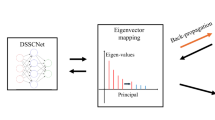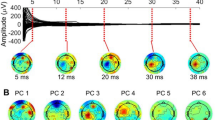Abstract
Neural network algorithms on principal component analysis (PCA) and minor component analysis (MCA) are of importance in signal processing. Unified (dual purpose) algorithm is capable of both PCA and MCA, thus it is valuable for reducing the complexity and the cost of hardware implementations. Coupled algorithm can mitigate the speed-stability problem which exists in most noncoupled algorithms. Though unified algorithm and coupled algorithm have these advantages compared with single purpose algorithm and noncoupled algorithm, respectively, there are only few of unified algorithms and coupled algorithms have been proposed. Moreover, to the best of the authors’ knowledge, there is no algorithm which is both unified and coupled has been proposed. In this paper, based on a novel information criterion, we propose two self-stabilizing algorithms which are both unified and coupled. In the derivation of our algorithms, it is easier to obtain the results compared with traditional methods, because it is not needed to calculate the inverse Hessian matrix. Experiment results show that the proposed algorithms perform better than existing coupled algorithms and unified algorithms.
















Similar content being viewed by others
References
Abdi H, Williams LJ (2010) Principal component analysis. Wiley Interdiscip Rev 2(4):433–459
Chen LH, Chang S (1995) An adaptive learning algorithm for principal component analysis. IEEE Trans Neural Netw 6(5):1255–1263
Chen T (1997) Modified oja’s algorithms for principal subspace and minor subspace extraction. Neural Process Lett 5(2):35–40
Chen T, Amari SI (2001) Unified stabilization approach to principal and minor components extraction algorithms. Neural Netw 14(10):1377–1387
Chen T, Amari SI, Lin Q (1998) A unified algorithm for principal and minor components extraction. Neural Netw 11(3):385–390
Cirrincione G, Cirrincione M, Hérault J, Van Huffel S (2002) The MCA EXIN neuron for the minor component analysis. IEEE Trans Neural Netw 13(1):160–187
Diamantaras KI, Kung SY (1996) Principal component neural networks: theory and applications. Wiley, New York
Diamantaras KI, Papadimitriou T (2009) Applying PCA neural models for the blind separation of signals. Neurocomputing 73(1):3–9
Du KL, Swamy M (2014) Neural networks and statistical learning. Springer, Berlin
Gao K, Ahmad MO, Swamy M (1992) Learning algorithm for total least-squares adaptive signal processing. Electron Lett 28(4):430–432
Golub GH, Van Loan CF (2012) Matrix computations, vol 3. JHU Press, London
Griffiths J (1983) Adaptive array processing. a tutorial. IEE Proceedings F (Commun Radar Signal Process) 130(1):3
Harmouche J, Delpha C, Diallo D (2012) Faults diagnosis and detection using principal component analysis and kullback-leibler divergence. In: 38th annual conference on IEEE industrial electronics society (IECON 2012), pp 3907–3912
Harmouche J, Delpha C, Diallo D (2014) Incipient fault detection and diagnosis based on kullback-leibler divergence using principal component analysis: Part I. Signal Process 94:278–287
Hasan M, et al (2007) Self-normalizing dual systems for minor and principal component extraction. In: IEEE international conference on acoustics, speech and signal processing, 2007 (ICASSP 2007), vol 4, pp IV–885
Hasan MA (2005) Natural gradient for minor component extraction. In: IEEE international symposium on circuits and systems, 2005 (ISCAS 2005), pp 5138–5141
Horn RA, Johnson CR (2012) Matrix analysis. Cambridge University Press, Cambridge
Hou L, Chen TP (2006) Online algorithm of coupled principal (minor) component analysis. J Fudan Univ 45(2):158–169
Hyvärinen A, Karhunen J, Oja E (2004) Independent component analysis. Wiley, New York
Jolliffe I (2005) Principal component analysis. Wiley Online Library, Hoboken
Kambhatla N, Leen TK (1997) Dimension reduction by local principal component analysis. Neural Comput 9(7):1493–1516
Klemm R (1987) Adaptive airborne MTI: an auxiliary channel approach. IEEE Proc F (Commun Radar Signal Process) 134:269–276
Kong X, An Q, Ma H, Han C, Zhang Q (2012) Convergence analysis of deterministic discrete time system of a unified self-stabilizing algorithm for PCA and MCA. Neural Netw 36:64–72
Kong X, Hu C, Han C (2010) On the discrete-time dynamics of a class of self-stabilizing MCA extraction algorithms. IEEE Trans Neural Netw 21(1):175–181
Kong X, Hu C, Han C (2010) A self-stabilizing MSA algorithm in high-dimension data stream. Neural Netw 23(7):865–871
Kong X, Hu C, Han C (2012) A dual purpose principal and minor subspace gradient flow. IEEE Trans Signal Process 60(1):197–210
Kong X, Hu C, Ma H, Han C (2012) A unified self-stabilizing neural network algorithm for principal and minor components extraction. IEEE Trans Neural Netw Learn Syst 23(2):185–198
Lai Z, Jin Z, Yang J, Sun M (2012) Dynamic transition embedding for image feature extraction and recognition. Neural Comput Appl 21(8):1905–1915
Luo FL, Unbehauen R (1997) A generalized learning algorithm of minor component. In: 1997 IEEE international conference on acoustics, speech, and signal processing (ICASSP-97), vol 4, pp 3229–3232
Luo FL, Unbehauen R, Cichocki A (1997) A minor component analysis algorithm. Neural Netw 10(2):291–297
Lv JC, Tan KK, Yi Z, Huang S (2010) A family of fuzzy learning algorithms for robust principal component analysis neural networks. IEEE Trans Fuzzy Syst 18(1):217–226
Manton JH, Helmke U, Mareels IM (2005) A dual purpose principal and minor component flow. Syst Control Lett 54(8):759–769
Mathew G, Reddy VU (1994) Development and analysis of a neural network approach to pisarenko’s harmonic retrieval method. IEEE Trans Signal Process 42(3):663–667
Miao Y, Hua Y (1998) Fast subspace tracking and neural network learning by a novel information criterion. IEEE Trans Signal Process 46(7):1967–1979
Möller R (2004) A self-stabilizing learning rule for minor component analysis. Int J Neural Syst 14(01):1–8
Möller R, Könies A (2004) Coupled principal component analysis. IEEE Trans Neural Netw 15(1):214–222
Nguyen TD, Takahashi N, Yamada I (2013) An adaptive extraction of generalized eigensubspace by using exact nested orthogonal complement structure. Multidimens Syst Signal Process 24(3):457–483
Nguyen TD, Yamada I (2013) Adaptive normalized quasi-Newton algorithms for extraction of generalized eigen-pairs and their convergence analysis. IEEE Trans Signal Process 61(6):1404–1418
Nguyen TD, Yamada I (2013) A unified convergence analysis of normalized past algorithms for estimating principal and minor components. Sig Process 93(1):176–184
Ouyang S, Bao Z, Liao GS, Ching P (2001) Adaptive minor component extraction with modular structure. IEEE Trans Signal Process 49(9):2127–2137
Ouyang S, Ching P, Lee T (2002) Quasi-Newton algorithm for adaptive minor component extraction. Electron Lett 38(19):1142–1144
Peng D, Yi Z, Lv JC, Xiang Y (2008) A stable MCA learning algorithm. Comput Math Appl 56(4):847–860
Peng D, Yi Z, Lv J, Xiang Y (2008) A neural networks learning algorithm for minor component analysis and its convergence analysis. Neurocomputing 71(7):1748–1752
Peng D, Yi Z, Xiang Y (2009) A unified learning algorithm to extract principal and minor components. Digit Signal Process 19(4):640–649
Qiu J, Wang H, Lu J, Zhang B, Du KL (2012) Neural network implementations for PCA and its extensions. ISRN Artif Intell 2012:1–19
Smith LI (2002) A tutorial on principal components analysis. Cornell Univ USA 51:52
Wang R, Yao M, Cheng Z, Zou H (2011) Interference cancellation in GPS receiver using noise subspace tracking algorithm. Signal Process 91(2):338–343
Xu L, Oja E, Suen CY (1992) Modified Hebbian learning for curve and surface fitting. Neural Netw 5(3):441–457
Yang J, Chen X, Xi H (2013) Fast adaptive extraction algorithm for multiple principal generalized eigenvectors. Int J Intell Syst 28(3):289–306
Ye M, Fan XQ, Li X (2006) A class of self-stabilizing MCA learning algorithms. IEEE Trans Neural Netw 17(6):1634–1638
Ye M, Yi Z, Lv J (2005) A globally convergent learning algorithm for PCA neural networks. Neural Comput Appl 14(1):18–24
Acknowledgments
The authors gratefully acknowledge that this work is supported in part by National Natural Foundation of China under Grant 61174207, 61374120, 61074072 and 11405267.
Author information
Authors and Affiliations
Corresponding author
Appendices
Appendix 1: Derivation of Coupled System
Suppose that \(\bar{\mathbf{W}}\) contains all eigenvectors of C in its columns \((\mathbf{w}_1, \ldots ,\mathbf{w}_n)\), coincides with eigenvalues \(\lambda _1 < \cdots < \lambda _n\). \(\bar{\varvec{\Lambda }}\) is a diagonal matrix containing all eigenvalues of C, which is, \(\bar{\varvec{\Lambda }}=\text {diag} (\lambda _1, \ldots , \lambda _n)\) . Suppose that \(\mathbf{e}_1=(1,0,\ldots ,0)^T\), then it holds that \(\mathbf{C}=\bar{\mathbf{W}}\bar{\varvec{\Lambda }}\bar{\mathbf{W}}^T\), \(\bar{\mathbf{W}}{} \mathbf{e}_1=\mathbf{w}_1\) and \(\bar{\mathbf{W}}^{-1}=\bar{\mathbf{W}}^T\) [11]. We have
In the vicinity of the stationary point \((\mathbf{w}_1, \lambda _1)\), by approximating \(\mathbf{w} \approx \mathbf{w}_1, \lambda \approx \lambda _1 \ll \lambda _j\ (2 \le j \le n)\), it holds that
Then we have
In this case, (10) and (11) change to
which equals to
Substituting (65) into (64), it yields
Premultiplying both side of (66) by \(\mathbf{w}^T\mathbf{C}^{-1}\), then we get
Substituting (65) into (67) and after some manipulations, we have that
Substituting (68) into (66), we can get
Then, the coupled dynamical system (12)–(13) is obtained.
Next we analyze the approximation error of the coupled system. It is found that
and hence
Substituting (71) into (10)–(11), we have that
where \(\Delta \dot{\mathbf{w}}\) and \(\Delta \dot{\lambda }\) denote the approximation error of \(\dot{\mathbf{w}}\) and \(\dot{\lambda }\), respectively. Similarly, we can get that
Since convergence analysis (see Sect. 4) shows that the coupled system (12)–(13) has the only stable stationary point \((\mathbf{w}_1,\lambda _1)\) and it holds that \(\mathbf{w}^T_1\mathbf{w}_1=1\). Substituting \(\mathbf{w}^T\mathbf{w}\approx 1\) into (74)–(75), it holds that \(\Delta \dot{\mathbf{w}}\approx \mathbf{0}\) and \(\Delta \dot{\lambda }\approx 0\). This means that the approximation error approaches to 0 in the vicinity of the stable stationary point.
Appendix 2: The Jacobian of fMCA
The Jacobian of coupled rule is defined as
For fMCA, we have
where
and
Similarly,
In the vicinity of the stationary point \((\mathbf{w}_1,\lambda _1)\), it holds that \(\mathbf{C}^{-1}{} \mathbf{w}_1\approx \lambda ^{-1}_1\mathbf{w}_1\), \(\mathbf{w}^T_1\mathbf{w}_1\approx 1\) and \(\mathbf{w}^T_1\mathbf{C}^{-1}{} \mathbf{w}_1\approx \lambda ^{-1}_1\). Then
Thus
and
It is also found that
and
To sum up, we get
Appendix 3: Proof of \(\lambda (k) > 0\)
The proof of aMCA, fMCA and aPCA are similar, thus we only take aMCA as an example. Suppose that C has the smallest eigenvalue \(\lambda _1\) and the largest eigenvalue \(\lambda _n\). We have proved that \(\mathbf{w}(k)\) is self-stabilized, or in other words, the norm of \(\mathbf{w}(k)\) converges to 1 automatically. In this case, we can approximate \(\mathbf{w}^T\mathbf{w}=1\) in each step. We have
which is the property of Rayleigh quotient [17]. From (23) we conclude that \(\mathbf{Q}=\mathbf{C}^{-1}\) has the smallest eigenvalue \(1/\lambda _n\) and the largest eigenvalue \(1/\lambda _1\). Thus
or in other words
Since \(\lambda (0)>0\) and \(0<\gamma (k)<1\) hold for all \(k \ge 0\), we can verify (21) as
for all \(k\ge 0\).
Rights and permissions
About this article
Cite this article
Feng, X., Kong, X., Ma, H. et al. Unified and Coupled Self-Stabilizing Algorithms for Minor and Principal Eigen-pairs Extraction. Neural Process Lett 45, 197–222 (2017). https://doi.org/10.1007/s11063-016-9520-3
Published:
Issue Date:
DOI: https://doi.org/10.1007/s11063-016-9520-3




